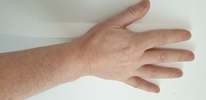-
Glossary of terms
Glossary of terms for Parkinson's and related conditions
As I come across them I will add to the list here
Dystonia :
Dystonia is a movement disorder in which a person's muscles contract uncontrollably. The contraction causes the affected body part to twist involuntarily, resulting in repetitive movements or abnormal postures. Dystonia can affect one muscle, a muscle group, or the entire body. Curled, clenched toes or a painful cramped foot are telltale signs of dystonia. Dystonia is a sustained or repetitive muscle twisting, spasm or cramp that can occur at different times of day and in different stages of Parkinson's disease (PD). For example, dystonia is a common early symptom of young-onset Parkinson's.
Dystonia is a movement disorder in which there are involuntary and repetitive muscle movements that cause a part of the body to twist or assume a particular posture. Various body parts can be affected by dystonia in Parkinson’s, including the eyes, neck, trunk and limbs. Dystonia can be painful and can interfere with a person’s desired movement. It’s important to note that many people with PD do not develop dystonia and conversely, there are numerous causes of dystonia which are unrelated to PD, including genetic disorders, brain lesions, and medication side effects.
DBS :
Deep brain stimulation (DBS) is a surgery to implant a device that sends electrical signals to brain areas responsible for body movement. Electrodes are placed deep in the brain and are connected to a stimulator device. Similar to a heart pacemaker, a neurostimulator uses electric pulses to regulate brain activity.
CBD :
CBD (Cannabidiol) is a natural compound found in cannabis sativa plants, with none of the adverse side effects of prescription medications and without the “high” effect from THC in marijuana. CBD may also reduce depression and anxiety, and relieve pain. A study at the Colorado School of Medicine has demonstrated relief of issues including tremors and difficulty sleeping. CBD studies are also showing it as effective in treating the psychosis that comes with PDD (Parkinson's disease dementia)
LBD :
Lewy body dementia (LBD) is a type of progressive dementia that leads to a decline in thinking, reasoning and independent function because of abnormal microscopic deposits that damage brain cells over time. Note, dementia with Lewy bodies presents with symptoms similar to Parkinson’s disease dementia (PDD). However, with LBD, cognitive issues are present prior to one experiencing issues with movement. All of these diseases are progressive, meaning the symptoms become worse as time goes on, and unfortunately there is no cure. According to the Alzheimer’s Association, approximately 50 to 80% of people with PD go on to develop PDD. On average, the development of dementia is 10 years after the onset of PD.
Tremors :
Characteristically occurring at rest, the classic slow, rhythmic tremor of Parkinson’s disease typically starts in one hand, foot, or leg and eventually affects both sides of the body. The resting tremor of Parkinson’s disease can also occur in the jaw, chin, mouth, or tongue. In addition, some people with Parkinson’s disease can experience a feeling of internal tremor, which is not necessarily noticeable to others.
Rigidity :
Rigidity refers to a tightness or stiffness of the limbs or torso. Rigidity, especially in the early stages of the disease, may be wrongly attributed to arthritis or orthopedic problems, such as a rotator cuff injury.
Bradykinesia :
Greek for “slow movement,” bradykinesia is a frequent symptom of Parkinson’s disease and related movement disorders. In addition to a general slowness of movement, the bradykinesia of Parkinson’s disease is typically demonstrated by a reduced or mask-like expression of the face (hypomimia or facial masking), a decreased blink rate of the eyes, and problems with fine motor coordination (for example, difficulties buttoning a shirt). Having trouble turning over in bed and slow, small handwriting (micrographia) are other signs of bradykinesia.
Postural Instability :
More pronounced in the later stages, postural instability includes the inability to maintain a steady, upright posture or to prevent a fall. Such balance problems in Parkinson’s disease are associated with a tendency to list or fall backward (retropulsion); in fact, a light push can cause the individual with Parkinson’s disease to continue stepping backward or to even fall down.
Walking or Gait Difficulties :
Bradykinesia and postural instability both contribute to walking—or gait—difficulties in Parkinson’s, particularly as the disease progresses. A common, early symptom of Parkinson’s disease is a decrease in the natural swing of one or both arms when walking. Later, steps may become slow and small, and a shuffling gait (festination) may appear. Gait problems in Parkinson’s disease can also include a tendency to propel forward with rapid, short steps (propulsion). People with advanced Parkinson’s disease may experience episodes of freezing, in which the feet appear to be glued to the floor.
Vocal Symptoms :
In addition to the five core motor symptoms of Parkinson’s, changes in the voice are commonly experienced. Generally, these are believed to be at least partly due to bradykinesia. The voice may become softer, or it may start off strong and then fade away. There may be a loss of the normal variation in volume and emotion in the voice, so that the individual may speak in a monotone. In more advanced Parkinson’s, speaking may become rapid, with the words crowded together, or stuttering may occur.
ICD :
The disease can affect the brain in ways that cause modest personality changes over time. Also, Parkinson’s medication can, in some instances, cause impulse control disorders (ICD). An ICD can manifest as hypersexuality, pathological gambling, and other impulsive behaviors.
